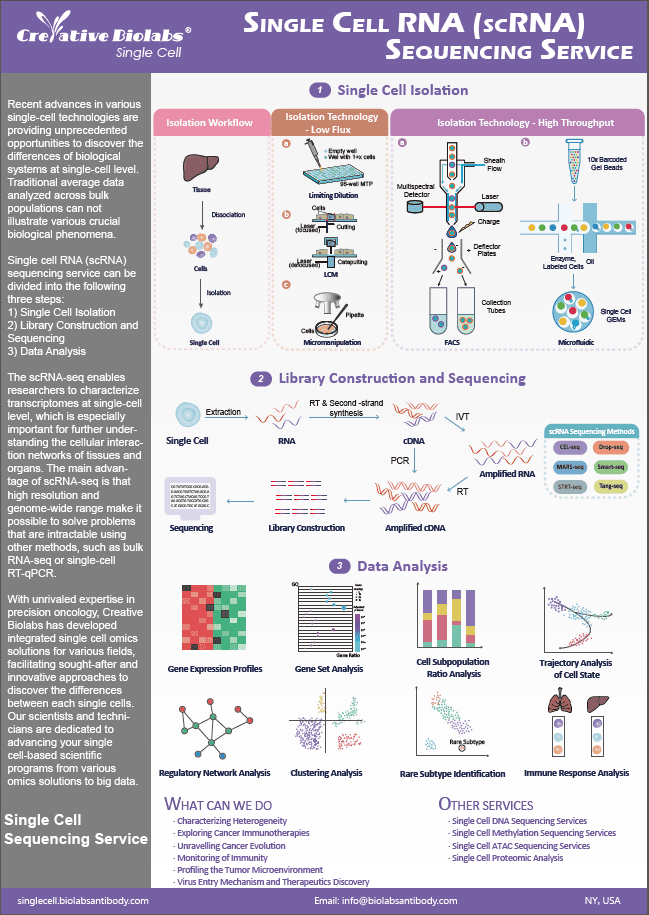- Home
- Single Cell Featured Services
- Single Cell Epigenetic Service
- Single Cell Gene Expression and ATAC
Single Cell Gene Expression and ATAC Service
Creative Biolabs provides a comprehensive range of customized, high-quality services in single cell gene expression and ATAC to support scientific research in related biomedical industries worldwide. With extensive experience and expertise, we offer single cell gene expression and ATAC service to understand the cell types and states, which enables deeper insights into gene regulatory programs that can investigate the complexities of diseases.
Chromatin Open Region
Eukaryotic chromosomes are formed by a series of folding events in nucleosome structures generated by DNA molecules wrapping histone proteins. There are some regions of chromatin that are loosely reformed, called open chromatin or open chromatin regions, where both DNA replication and gene transcription occur. Therefore, obtaining the information will help us understand the regulation of gene expression by open regions, as well as better understand biological regulation. ATAC-seq (Assay for Transposase Accessible Chromatin using sequencing), a research technique for chromatin accessibility, uses the modified Tn5 transposase to integrate its adapter payload into regions of accessible chromatin, therefore, amplifiable DNA fragments suitable for high-throughput sequencing are preferentially generated at locations of open chromatin, which can help reveal the interplay between genomic locations of open chromatin, DNA binding proteins, individual nucleosomes, and higher-order compaction at regulatory regions with nucleotide resolution (Buenrostro; et al., 2013).
Single Cell Multiome ATAC and Gene Expression
The 10x Genomics single cell ATAC and gene expression technology offers a comprehensive, scalable multi-omic technique for simultaneously analyzing epigenomic landscape and gene expression in the same single nucleus. The relationship between chromatin accessibility and gene expression is more objective and genuine through this way, which is also useful in determining gene expression regulation. The technological principle of the technique is depicted as follows.
Our Single Cell Gene Expression and ATAC Service
Creative Biolabs offers scientific and meticulous design for cell suspension, library construction, sequencing and data analysis to ensure high-quality research results. We provide a comprehensive multi-omic approach for profiling epigenomic and gene expression at the single cell level.
Features & Benefits
1. High throughput
About 500-10,000 nuclei can be obtained per channel efficiently; for high throughput platform, we can run 8 samples (80,000 nuclei per run) in one experiment.
2. High resolution
The gene expression and chromatin accessibility information can be obtained at a single-cell nucleus level.
3. High capture efficiency
The capture efficiency of nuclei can reach up to 65% per sample.
4. More comprehensive information
We can get information on all open chromatin regions, not limited to a single transcription factor.
5. One-stop service
We can provide one-stop service from sample processing to data visualization; or provide customized analysis procedures with the most up-to-date technical solutions.
Results Display
Here are some results displayed that refers to the drawings of single cell multiome ATAC and gene expression articles.
1. Identifying distinct cell-type clusters from epigenomic and transcriptomic datasets.
 Fig.1 Our Single Cell Gene Expression and ATAC Service. (Creative Biolabs)
Fig.1 Our Single Cell Gene Expression and ATAC Service. (Creative Biolabs)
2. Differentially accessible region locations for each cell type.
 Fig.2 Distribution of chromatin accessible regions. 1
Fig.2 Distribution of chromatin accessible regions. 1
3. Co-accessibility networks near the interested locus analysis.
 Fig.3 TF activity and chromatin interaction networks. 1
Fig.3 TF activity and chromatin interaction networks. 1
4. Characterization of cell state transition using a multi-omics approach.
 Fig.4 Gene expression and chromatin accessibility dynamics along the pseudo time trajectory.1
Fig.4 Gene expression and chromatin accessibility dynamics along the pseudo time trajectory.1
Application Prospect
Single cell gene expression and ATAC service can provide multi-omic analysis for the same single cell, and help researchers get insight into tumor heterogeneity, mechanisms of gene regulation, and have a wide range of applications in the fields of neurodegenerative or immunological diseases.
 Fig.5 Applications of single cell gene expression and ATAC. (Creative Biolabs)
Fig.5 Applications of single cell gene expression and ATAC. (Creative Biolabs)
If you want to know more about our services, please feel free to contact us for your tailored solution.
Q&As
Q: What cell types can be analyzed with this service?
A: Virtually any cell type can be studied, including rare and heterogeneous populations, enabling comprehensive exploration of tissue-specific functions and disease-associated cell states.
Q: How does it compare to traditional bulk sequencing methods?
A: It surpasses bulk methods by revealing cell-to-cell variability and regulatory dynamics that are masked in averaged measurements, providing a more nuanced view of biological systems.
Q: What are the technical capabilities of the service?
A: It includes robust single-cell isolation, sensitive RNA and chromatin profiling, and advanced bioinformatics for integrated analysis of transcriptomic and epigenomic data.
Q: How does it benefit therapeutic/drug development research?
A: By identifying cell-specific gene expression profiles and regulatory chromatin landscapes, it aids in discovering novel drug targets, understanding disease mechanisms, and optimizing therapeutic strategies.
Q: What sample types are compatible with this service?
A: The sevice is compatiable with a wide ranger of samples, including fresh, frozen tissues, as well as cell lines and primary cells from various organism.
Resources
Reference
- Muto, Yoshiharu et al. "Single cell transcriptional and chromatin accessibility profiling redefine cellular heterogeneity in the adult human kidney." Nature communications vol. 12,1 2190. 13 Apr. 2021, doi:10.1038/s41467-021-22368-w. Distributed under Open Access license CC BY 4.0, without modification.
Search...


